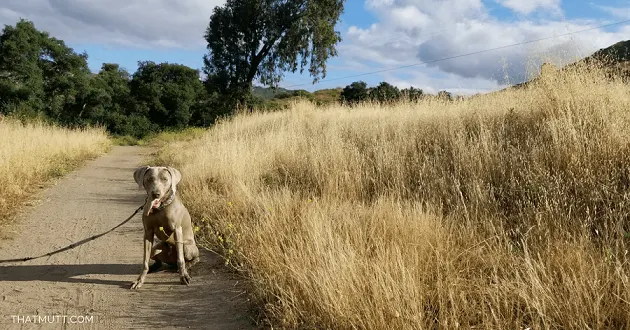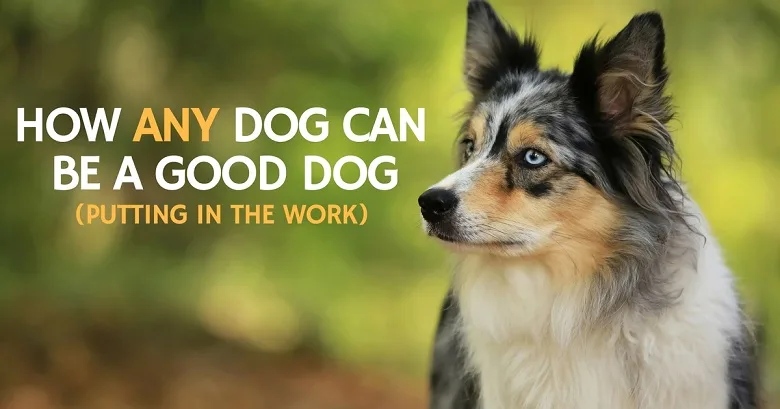It’s the small, consistent decisions we make every day that have the greatest impact on our lives, good or bad.
I’m reading a book called The Slight Edge, and that is the main point author Jeff Olson is trying to make. Essentially, do the work and it pays off in the long run.
This can apply to almost anything. Olson was not referring to dog training, but of course that is what I thought of immediately.
For example:
I choose to walk my dogs every day. I’ve done this ever since I adopted Ace in 2007. We walk. Every day. (2019 update: Ace has passed away.)
Each walk on its own is not all that important. We could miss a day and it wouldn’t matter.
But the decision to walk every day over time allows me:
- Better health and fitness
- A more relaxed mind and soul
- Special time with each dog
- A break in my day for better overall productivity
And for my dogs:
- Exercise = better health & better behavior
- Movement for my senior dog = less stiffness
- Being out in the world = better socialization and well-rounded, happier dogs

So how does this apply to dog training?
Most of us get frustrated when it comes to training because we want a quick fix to a behavior problem like pulling on the leash or barking when sometimes there is no quick fix.
I get emails every day with questions from people wondering what magical thing they can do to stop a dog’s resource guarding or jumping or whining.
There’s rarely a quick fix, but the answer is usually fairly simple.
It’s putting in the time, a few minutes a day. This is what’s very difficult for people. Consistency.
For example, my dog Remy pulls on the leash and I’ve been planning this big, elaborate plan to do a 30-day loose leash walking challenge. That sounds great, but in reality that’s not going to work. It’s too overwhelming to plan out 30 days and I won’t even be with my dog for 30 days in a row all summer due to travel.
But that doesn’t matter. Because it’s much simpler than that. All I need is a few minutes each day. And I can start right now.
With loose-leash walking, all it really comes down to is holding the leash loose, not tight, and taking a step back when my dog pulls. The leash loosens, we move forward. No treats needed. No correction needed. Just a few minutes of patience every day.
I won’t see much of a difference in the first week or the week after or the week after that. But over many weeks, I’ll see a big difference!

Another example: Jumping.
My dog Remy jumps on me when he’s excited. It hurts, and I have bruises and scratches from the little weimamonster.
Scolding him and getting mad doesn’t work. He doesn’t take me seriously and he just gets more riled up.
So my new plan is: Don’t engage with him at all when he jumps.
The first day I do this, it will have no impact. He’ll probably still jump on me a dozen times! The second day, he’ll still jump.
But after a few weeks of totally ignoring Remy for jumping, you bet it’s going to pay off! Because his jumping will cause me to become completely emotionless, 100% disengaged from him. I will stare at my phone or leave the room entirely.
What training problems are the rest of you facing?
Could any of this work for you?
Let’s say your dog barges through the door when you want to take him out for a walk. I’m sure you could make some small changes that would add up over time. For example, you don’t open the door until that little butt is on the ground. He might only sit for a second the first day, but he’ll get better.
Or, if your dog has a problem giving up his toys or letting go of other items he steals, you could spend just 2 minutes a day working on “drop” with high-valued treats. This will make a big difference over time. “Oh, you want me to drop the toy and I get hot dogs? COOL! OK!”

This applies to anything. Coming when called, aggression around other dogs, working on tricks.
I want my dog to learn to do a front handstand because I think that’s a cool trick. So I have to start with the most basic movements. It’s not that I have to be a better trainer than anyone else or have a genius dog. I just have to put in the time when most people don’t.
Sure, some dogs are MUCH harder to train than others and some have more emotional problems or bad habits. But that doesn’t mean they can’t make progress too.
So, in the comments. Let me know if you’ve thought of a problem you’d like to work on with your dog and what the first step would be. If you’re having trouble deciding where to start, I’ll see if I can help.
What dog training issue are you working on right now?
Let me know in the comments.
I was inspired to write this post while reading the book The Slight Edge. Order it if you’re into personal development type books.
-Lindsay, Ace & Remy

Michelle Hollywell
Monday 9th of April 2018
My girl is a rescue from a drug house. She wasn't physically abused, but mentally and four years later, I'm still having trouble helping her work through it. She's fine with some dogs, but not all and fine with some people, but not all. I never know when she's going to snap and I still can't tell what her triggers are. The best thing I've done when she's losing her mind, is to gently touch her and bring her focus back. I changed her name when she was adopted, to separate her new life from her old life. Any other suggestions would be greatly appreciated.
Lindsay Stordahl
Monday 9th of April 2018
You might want to look into Patricia McConnell's two books, "Feisty Fido" and "Cautious Canine." She uses desensitization and counter-conditioning to change a dog's emotional response to her triggers. I find the books easy to follow.
Cara
Monday 9th of April 2018
My 5 year old dog Maggie, (Pom/Sheltie mix) is super fearful and aggressive of/toward other people/ dogs. She loves me, my family, and that's it. Walking her is a nightmare. please help!
Lindsay Stordahl
Monday 9th of April 2018
I wrote a post on that topic. See if this helps you brainstorm: https://www.thatmutt.com/2015/07/08/stop-a-dog-from-barking-and-growling-at-other-dogs-on-walks/
Shelby & Otis
Wednesday 4th of October 2017
We have troubles were working threw walking, and unpredictable growling at company. We are making progress with both, slowly and with the help of a prong collar, and muzzle.
There is one thing I could sure use some advice with. When Otis wants my attention he will stand in front of me and bark in my face. I try to ignore it wait for him to stop barking before petting him, playing with him, or taking him outside. Unfortunately ignoring him only makes him bark louder and climb in my lap and lick me in my face. I try to stand up but he weighs 72 lbs a big boy. I always end up having to repeat down and push him off. He's very persistent soon as I get him off me he starts barking again. All I can do is walk away and lock my self in the bathroom. Until I'm calmed down and so is he then I'll see what exactly it is he needs. When I was potty training him I loved it when he came to me and barked to let me know he needed out. Now I wish I would've tried teaching him to ring a bell or go to door when he needed out. I feel like he figures that barking in my face will work for everything he wants now! I pretty much know when its to go out and when he is just demanding my attention now! I also know that by throwing the ball he dropped in front of me to get him out of my face and to shut him up is giving him his way therefore ensuring that he continues the behavior. If I stand up he can't climb on me but he don't stop barking and pushing me with his head. If I tell him hush, he don't and if I ignore it it gets louder and worse. The only thing I can do is lock myself in a different room and wait for him to give up. Its nerve wracking and it also interferes with whatever I'm doing when he decides to be bossy! Honestly he does get plenty of attention, exercise, and has toys like his Kong he could entertain his self with. I'm pretty consistent and patient with him, but this behavior frustrates me to the point that he more often then not gets his way! Any suggestions ????? M
Lindsay Stordahl
Thursday 5th of October 2017
Hi Shelby (and Otis!), that behavior sounds so annoying! Remy my weimaraner does this too although not as often. When I sit on the couch, he will not stop pawing at me and shoving his toys at me. He usually doesn't bark, thankfully, but sometimes he does and I find it very rude.
What we've finally started doing this week with him is being firm with our "go to your bed" command. We'll give him a few warnings first. We say "That's enough!" in a mean voice when we don't want him bothering us. If he doesn't stop, I say "go to your bed" and put him in a down/stay on his blanket. He won't listen usually, so I have to use treats but he'll stay there for 10 minutes or so with me giving a treat every 2-3 minutes. We had to start with giving treats more often. So that is one thing you could consider doing your own version of that.
Also, do you have a separate area you could move Otis to when you know he's likely to act this way? Maybe putting him in his crate with a Kong stuffed with peanut butter or putting him behind a baby gate or in another room with something to chew on like a bully stick? I imagine he does this behavior at certain times of the day and maybe you could give him something to do before the barking starts.
Kathy
Monday 2nd of October 2017
My dog play bites when he is excited, which happens whenever he greets someone. He is 11 months old and 35 lbs. I am nervous he will hurt someone. I would rather not put a muzzle on him.
Colleen A.
Sunday 1st of October 2017
We have a 7 month old Beagle/Husky mix. We are working on trying to trim her nails. I took her to our vet and they said I had to bring her back when she took a sedative before they would trim them. I then tried a dog groomer. She was able to trim them the first time we took her, but when we went back to have them trimmed again our dog did not want anything to do with it and the groomer said I had to either get her tranquilized or take her to a dog trainer. She said this to me as my dog sat right next to my leg and did not move. My dog sits, stays, comes (most of the time) and follows a few other basic commands. She does not try to bite us or anything, but she goes crazy when we try to trim her nails. We have been working on desensitizing her by distracting her with treats while I tap the clippers to her nail and then we may get one or two nails trimmed ( we do this about 5 minutes a day). Is this the right approach or do you have another suggestion we could try. Thanks - and btw LOVE your blog, I have learned so much in the last few months on training "Hattie".
Lindsay Stordahl
Sunday 1st of October 2017
Oh gosh, those nail trims are so hard for some dogs! How stressful. Have you seen this post on nail trims? https://www.thatmutt.com/2016/09/13/how-to-get-a-dog-to-tolerate-nail-trims/
It sounds similar to what you are doing. I'm glad you've been able to make a little progress and trim at least a nail or two at a time.